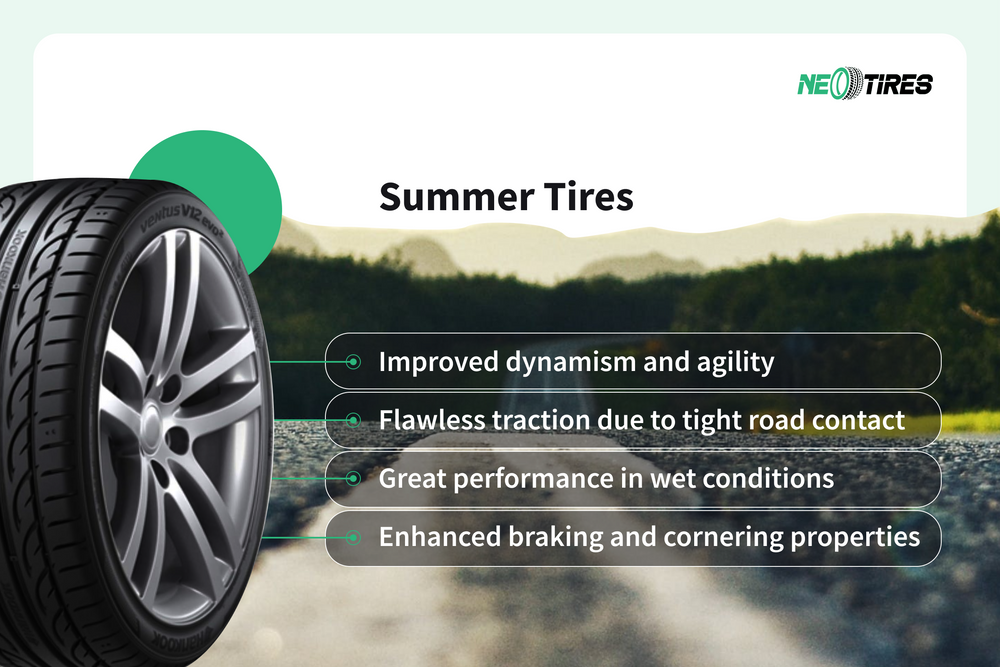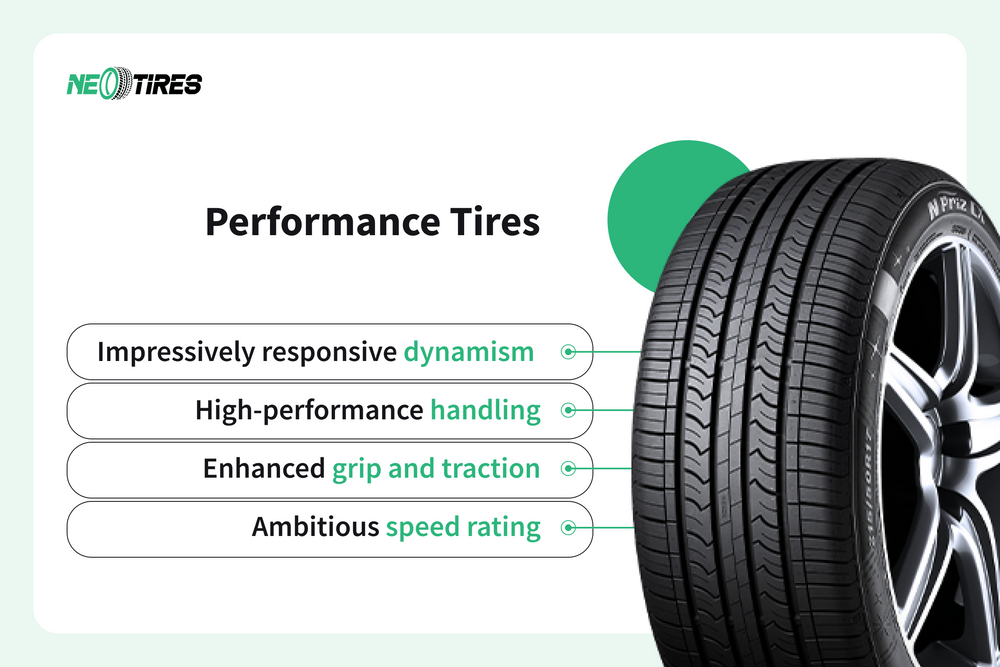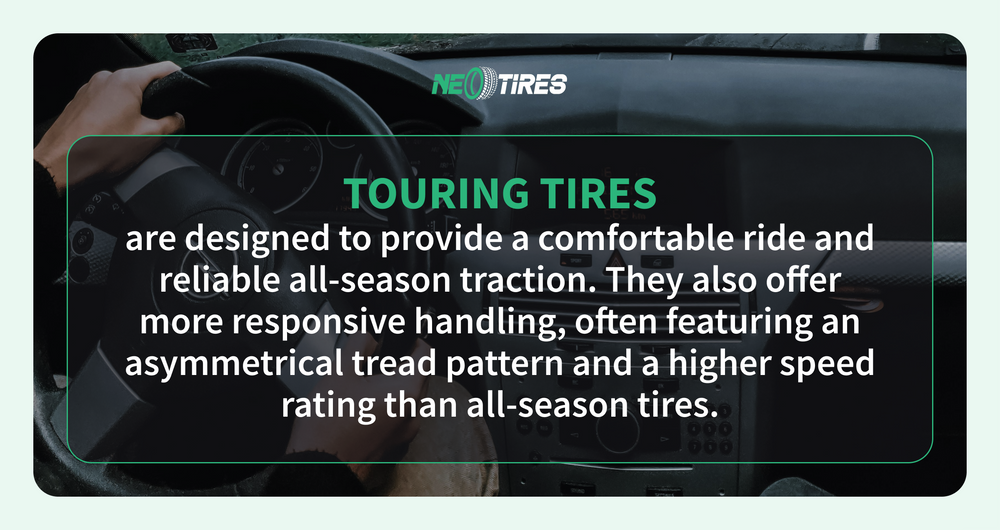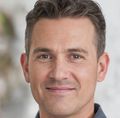Choosing the right tires for your car can be a challenging process. That is because you need to decide on the tire type, apart from its size, diameter, and tread pattern, which will determine your further performance. This guide walks you through various types of tires, enabling you to make an informed choice for your specific needs. From seasonal options to products for aggressive terrain, you will get a better understanding of what exactly your best match is.
Main Types of Tires
Not all tires are the same. Manufacturers craft them according to season and terrain type to ensure their versatility in various conditions. We can distinguish seven types of tires for different seasons and terrains: all-season, summer, winter, all-terrain, mud-terrain, performance, and touring tires. Three other types are available for supportive purposes: truck tires (to support heavy loads), spare/temporary tires (backup support on the road), and run-flat tires (support during tire failure).
| Tire Type | Best For | Pros | Cons |
|---|---|---|---|
| All-Season | Everyday driving in mild climates | Versatile, long tread life, quiet ride | Not ideal for extreme winter or hot weather |
| Summer | Warm-weather performance | Excellent grip, responsive handling | Poor performance in cold or icy conditions |
| Winter | Snow, ice, and freezing temps | Superior cold-weather traction | Wears quickly in warm weather |
| All-Terrain | On- and off-road versatility | Durable, good in gravel & dirt | Louder, lower fuel efficiency |
| Mud-Terrain | Serious off-road use | Aggressive tread, best in mud & rocks | Noisy on highways, wears faster on pavement |
| Performance | Sports cars, spirited driving | Enhanced grip, cornering, braking | Costly, not ideal for rough roads |
| Touring | Long-distance highway driving | Smooth, quiet, high tread life | Limited off-road capability |
| Run-Flat | Emergency puncture support | Drive up to 50 miles after a puncture | Harsher ride, more expensive |
| Truck | Towing, hauling, heavy-duty use | Strong sidewalls, high load capacity | Rougher ride, more fuel consumption |
| Spare | Emergency use only | Compact, lightweight | Not for long-term driving |
All-Season Tires: Versatility is Key
The all-season tire type is ideal for most weather conditions, except for extreme winter conditions. All-season rubber is optimized for temperate climates, including wet and dry conditions. AS tires are a good choice for drivers who do not need a seasonal tire change, as the temps remain within the limit of 45°F (7°C) in the cold season.
All-weather tires are a variation that offers winter reliability that all-season tires lack. They are a better option for areas with extreme winters and low temperatures.
A good example of an all-season tire is the Michelin Defender T+H. This product offers exceptional longevity, comfort, quietness, and versatility, perfectly describing the concept of a true all-season tire.
Summer Tires: Hot Weather Experts
Summer or performance summer tires have a soft tread compound to ensure superior grip on smooth roads. They deliver excellent dry and wet traction, providing dependable stability in cornering and braking.
When temperatures drop, summer tires' rubber becomes stiff, leading to poor grip, which is why you should limit their use in cold weather. Learn more about Summer Tires: Performance & Benefits in our complete guide.
A great example of a performance tire is the Continental ExtremeContact Sport. This product provides reliable handling and balance on both dry and wet surfaces, making it an excellent choice for cars with a sporty vibe.
Winter Tires: The Cold Pros
Winter tires feature a special rubber compound that remains flexible even in extreme temperatures. This feature lets them grip snowy roads and maintain maximum traction in cold weather. Additionally, winter tires feature deep tread patterns that enable them to bite through snow and ice, providing a 25-30% shorter braking distance than all-season tires in extreme snow conditions.
As temperatures rise, the rubber becomes too soft, resulting in poor traction, reduced grip, and increased fuel consumption. These premises make winter tires unsuitable for the warm season, and it is recommended to change them once the temperature threshold passes 7 °C (46 °F).
The Bridgestone Blizzak WS90 is a notable example of a winter tire that excels in providing reliable ice grip and control in snowy conditions.
All-Terrain Tires: The Go-Anywhere Option
All-terrain tires are the best option for drivers who spend time on both highways and off-road terrains. This type is primarily compatible with SUVs, trucks, and off-road vehicles that frequently travel on uneven surfaces as well as smooth roads. The main features of all-terrain tires include rigid sidewalls, superior tolerance to abuse and damage, decent highway comfort, and an aggressive tread pattern for enhanced off-road traction.
The BFGoodrich All-Terrain T/A KO2 perfectly exemplifies the essence of an AT tire. This product is highly resistant to damage and excels at tackling rough terrain with superior traction.
Mud-Terrain Tires: When the Wild is Not a Challenge
Mud-terrain tires are a more aggressive and rugged version of all-terrain (AT) products. This type stands out with a bold tread featuring deep blocks and self-cleaning patterns. MT tires excel in deep mud, gravel, rocky trails, and other challenging obstacles that other types of tires struggle to handle. These products are best suited when you need exceptional grip and handling to navigate loose dirt and all off-road conditions.
MT tires' tradeoff is the noise they generate and the rapid tread wear that occurs when switching to smooth roads. So, you should keep them exclusively for challenging adventures in the wild.
A worthy example is the Toyo Open Country R/T Pro. This new MT tire promises and delivers exceptional traction on the most challenging terrains, extreme protection against cuts and abuse, and superior performance in any rugged environment.
Performance Tires: Where Speed Meets Control
Performance tires are designed to amplify high-performance vehicles' tenacity, cornering precision, and acceleration. This tire type brings out the full potential of sports cars' suspensions and powerful engines. Performance tires typically feature low profiles, soft rubber for superior grip, and stiff sidewalls for cornering stability.
One of the top-ranked models in this category is the Pirelli P Zero, which delivers exceptional precision and superior responsiveness to driver inputs.
Touring Tires: When Comfort for the Long Haul is Key
Touring tires are renowned for their exceptional tread longevity and comfort. They feature a special, wear-resistant rubber compound that dampens noise and flexes shocks for maximum comfort. Additionally, touring products prioritize fuel efficiency, making them a viable option for budget-conscious drivers.
The Goodyear Assurance ComforTred Touring is a perfect example to show the nature of a touring tire. Featuring a Comfort Layer for shock absorption, a dual-layer ComfortEdge sidewall, a mildly asymmetric tread design, and reinforced twin steel belts inside, everything about this tire works to ensure longevity, comfort, and fuel efficiency.
Truck Tires: A Promise For Heavy-Duty Performance
Truck tires are engineered to support the towing and hauling demands of heavier vehicles, including pickup trucks, vans, and larger SUVs. They usually feature an LT (light truck) label or C/D/E Load ratings, which refer to their load-carrying capacities.
Truck tires offer superior weight resistance, making them ideal for towing and carrying extra cargo in construction, transportation, or delivery applications. Depending on the purpose and terrain, they are typically available in all-season, all-terrain, or highway variations.
The Michelin LTX A/T2 model is an excellent example of an all-terrain tire suitable for trucks, thanks to its high load-carrying capacity and resistance to wear under demanding conditions.
| Label | Stands For | Best For |
| LT | Light Truck | Towing, hauling, heavy work |
| P | Passenger | Light-duty work, daily use |
Truck Tire Tip: LT vs P-Metric: LT tires are a better solution for frequent towing or heavy cargo loads. P-metric tire alternatives are more suitable for daily commuting in a pickup with no additional cargo.
Spare/Temporary Tires: When Emergency Calls
Spare tires are an emergency solution when one of your tires goes flat and needs to be replaced to reach a safe spot. Spare tires can be donut or full-size, the difference between them being their size. While full-size options are identical to regular tires, donuts are lightweight and compact, saving space.
Unlike a full-size spare tire, a donut is designed for a short distance of up to 50 miles. Considering its different size and pressure compared to other tires, its more extended use does not necessarily ensure safety.
Run-Flat Tires: Full Control After a Puncture
Run flats are a modern solution that enables a vehicle to continue moving after a total loss of pressure. While a regular tire requires replacement or repair to maintain the necessary pressure, a run-flat tire retains its shape due to its reinforced construction. This way, you can continue driving for an extra 50 miles under 50 mph safely to reach a repair shop or your garage.
Bridgestone DriveGuard is a favorite option in the run-flat tire category. The product is compatible with most vehicles, enabling drivers to continue driving after a tire pressure loss without requiring a roadside tire change.
Why Knowing Tire Types Is Important?
Tires significantly contribute to driving performance, influencing traction, fuel efficiency, handling, and safety. Selecting the wrong tire for the conditions in which you drive most often can lead to traction difficulties and increased engine effort, resulting in higher fuel consumption.
Imagine summer (performance) tires in off-road conditions. The rubber of performance tires is soft and does not provide a smooth grip on off-pavement surfaces. It does not provide the necessary traction on gravel, resulting in poor traction and performance deficiency. All-terrain or mud-terrain tires are a much more efficient and safe alternative in such circumstances.
What's the Right Tire Type for Your Needs?
The right type of tires depends exclusively on the driving conditions and your unique needs. All-season tires are the go-to option for drivers living in a mild area. Touring products are a comfortable choice for road trip enthusiasts. All-terrain (A/T) and mud-terrain (M/T) tires are indispensable for off-road adventurers, while winter options are designed for those who need reliable traction during winter storms. Here is a comprehensive breakdown to support your tire-buying decision:
Driving Style / Need | Recommended Tire Type |
Daily commuting | All-Season, Touring |
Snowy winters | Winter |
Hot summer driving | Summer, Performance |
Long highway trips | Touring, All-Season |
Weekend off-roading | All-Terrain |
Deep mud, rough trails | Mud-Terrain |
High-speed performance | Performance, Summer |
Tire type recommendations based on specific driving conditions and needs
Tire Types: FAQs
Can You Have 4 Different Tires?
You should not mix different types of tires. All tires must be of the same size, tread, type, and ideally, by the same manufacturer. Some exceptions refer to "staggered-fitted vehicles" with different tire widths on the front and rear, which is a purpose-built setup. Mount at least two identical tires on the same axle, if mounting four tires is not possible.
Need Support in Fitting Your Needs With the Right Tire?
We hope that the Tire Types section helped you better understand what suits you best. If you have any unclear aspects (such as tire size, best price, or highest rating), we are here to provide answers. Explore our catalog or simply click the Call button. The NeoTires team is ready to assist and provide the best solutions for your needs. Drive safe and choose your tires wisely!








